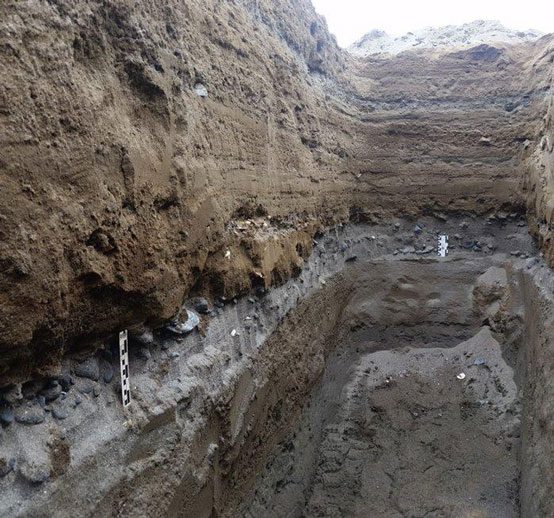A chilling discovery about an event that occurred 3,800 years ago in the Atacama Desert serves as a harsh warning of a potential disaster that could repeat itself, far beyond what modern human warning systems have predicted.
The Atacama Desert, known as one of the most inhospitable deserts in the world, is located in Chile and has long been recognized for its extremely complex geological history, having been dominated by various monstrous phenomena and ancient human groups that came and went.
According to Science Alert, a new international study led by anthropologist Diego Salazar from the University of Chile reveals that the coastal strip of Atacama was once inhabited about 3,800 years ago. However, shortly thereafter, traces of human life abruptly “disappeared” for 1,000 years before reappearing.

A deep hole excavated by researchers revealing remnants of human life disrupted by a disaster – Photo: SOUTHAMPTON UNIVERSITY
This led scientists to investigate marine sediments. Numerous traces belonging to humans and animals were unexpectedly uncovered: they had existed for a considerable time in the quiet coastal area before being suddenly thrust deep inland.
The study, recently published in Science Advances, also indicates that the land structure was unusually uplifted during the period 3,800 years ago.
According to geologist and tsunami expert James Goff from the University of New South Wales (Australia), a member of the research team, this could only have occurred due to an unimaginably massive tsunami.
The source of this super tsunami was a “monster” earthquake measuring 9.5 on the Richter scale. In comparison, the infamous earthquake in April 2015 that triggered a series of disasters across regions in Nepal and India, causing landslides on Mount Everest and resulting in at least 8,000 fatalities, had a magnitude of 7.8 or 8.1.
This area has long been considered “vulnerable” to super earthquakes due to its proximity to the convergence of the Nazca and South American tectonic plates.
3,800 years ago, the inhabitants of this region were a Stone Age community that primarily relied on hunting and gathering. The chain of super disasters overturned rock structures twice, accompanied by a powerful tsunami that wreaked havoc both as it crashed ashore and as it receded back into the sea, taking everything with it.
The destruction was so severe that the impact on any surviving humans must have been profound, rendering the entire area uninhabited for nearly 1,000 years, despite this land having been a familiar settlement for ancient humans for the previous 10,000 years.
According to Dr. James Goff, the underlying cause stems from the ongoing movement of tectonic plates, suggesting that the “super monster” from the earth could rise again. Currently, the area is densely populated and a popular tourist destination, making any potential disaster catastrophic “unless we learn from this discovery,” he emphasized.





















































